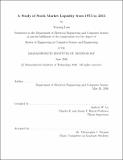| dc.contributor.advisor | Andrew W. Lo. | en_US |
| dc.contributor.author | Luo, Yiyang, M. Eng. Massachusetts Institute of Technology | en_US |
| dc.contributor.other | Massachusetts Institute of Technology. Department of Electrical Engineering and Computer Science. | en_US |
| dc.date.accessioned | 2016-12-22T15:17:15Z | |
| dc.date.available | 2016-12-22T15:17:15Z | |
| dc.date.copyright | 2016 | en_US |
| dc.date.issued | 2016 | en_US |
| dc.identifier.uri | http://hdl.handle.net/1721.1/105979 | |
| dc.description | Thesis: M. Eng., Massachusetts Institute of Technology, Department of Electrical Engineering and Computer Science, 2016. | en_US |
| dc.description | This electronic version was submitted by the student author. The certified thesis is available in the Institute Archives and Special Collections. | en_US |
| dc.description | Cataloged from student-submitted PDF version of thesis. | en_US |
| dc.description | Includes bibliographical references (pages 63-66). | en_US |
| dc.description.abstract | In this thesis we analyze US stock market liquidity in the period of 1973 to 2015 from three perspectives: price impact, turnover ratio, and trading frequency. We use the Center for Research in Security Prices (CRSP) and Trade and Quotes (TAQ) databases to acquire stock data across different time spans to perform analysis across different time horizons, including stock listing and de-listing analysis using monthly trades data, price impact and turnover ratio analysis using daily trades data, and intraday trading frequency case studies using intraday trades data. We first analyze price impact of all common stocks in the US stock market from 1973 to 2015 using linear regression between the a stock's holding period return and the natural log of its dollar trading volume to estimate the price impact. We then perform frequency decomposition of price impact time series and reconstruct price impact time series using Inverse Discrete Fourier Transform. We find market liquidity cycles of 8.6 years and 4.3 years and analyze the implications of these liquidity cycles in the context of economic cycles. Next we analyze turnover ratio of all common stocks in the US stock market from 1973 to 2015. We find evidence for the turnover ratio increasing more for illiquid stocks than liquid stocks in response to market events. Through an analysis of the trailing 2 year correlation between turnover ratio and price impact, we show that this correlation in liquid stocks steadily increases starting from the early 1990s, possibly due to the proliferation of day traders. Finally we perform intraday cases studies for the 2007 Quant Meltdown, first day of the 2008 Financial Crisis' worst week, and the 2010 Flash Crash respectively. We use the number of trades within one minute as a proxy for trading frequency. We find evidence for most trades happening around 10am and towards the end of the trading day around 3:30pm; hence the market liquidity are most abundant during these peak time. We also provide a method to investigate irregular market behavior and intraday liquidity shocks from unusual increases and decreases in trading frequency during the day. | en_US |
| dc.description.statementofresponsibility | by Yiyang Luo. | en_US |
| dc.format.extent | 66 pages | en_US |
| dc.language.iso | eng | en_US |
| dc.publisher | Massachusetts Institute of Technology | en_US |
| dc.rights | M.I.T. theses are protected by copyright. They may be viewed from this source for any purpose, but reproduction or distribution in any format is prohibited without written permission. See provided URL for inquiries about permission. | en_US |
| dc.rights.uri | http://dspace.mit.edu/handle/1721.1/7582 | en_US |
| dc.subject | Electrical Engineering and Computer Science. | en_US |
| dc.title | A study of stock market liquidity from 1973 to 2015 | en_US |
| dc.type | Thesis | en_US |
| dc.description.degree | M. Eng. | en_US |
| dc.contributor.department | Massachusetts Institute of Technology. Department of Electrical Engineering and Computer Science | |
| dc.identifier.oclc | 965653805 | en_US |
